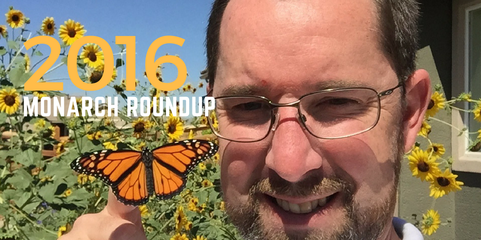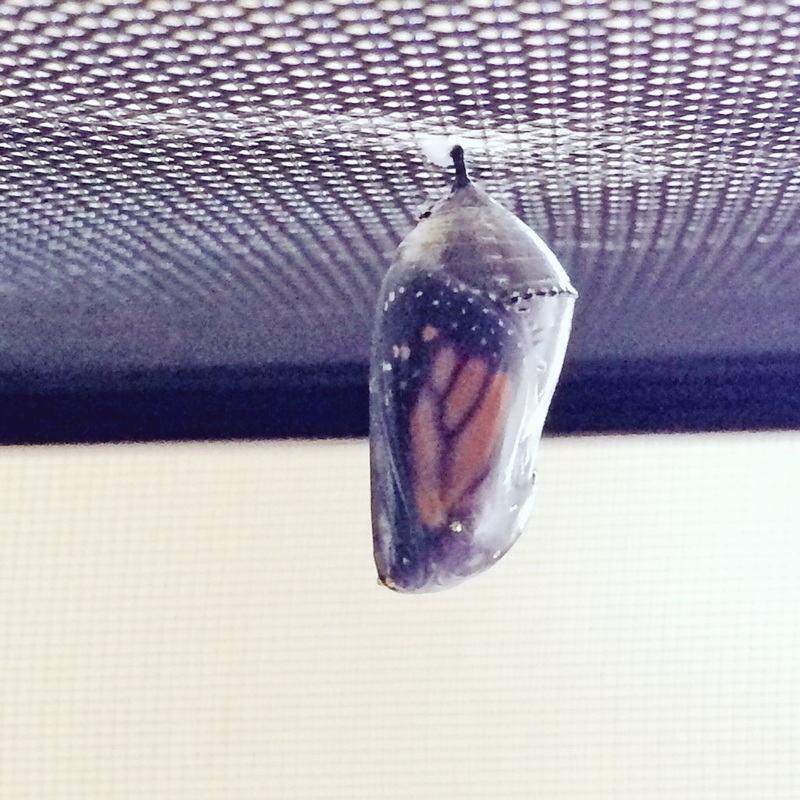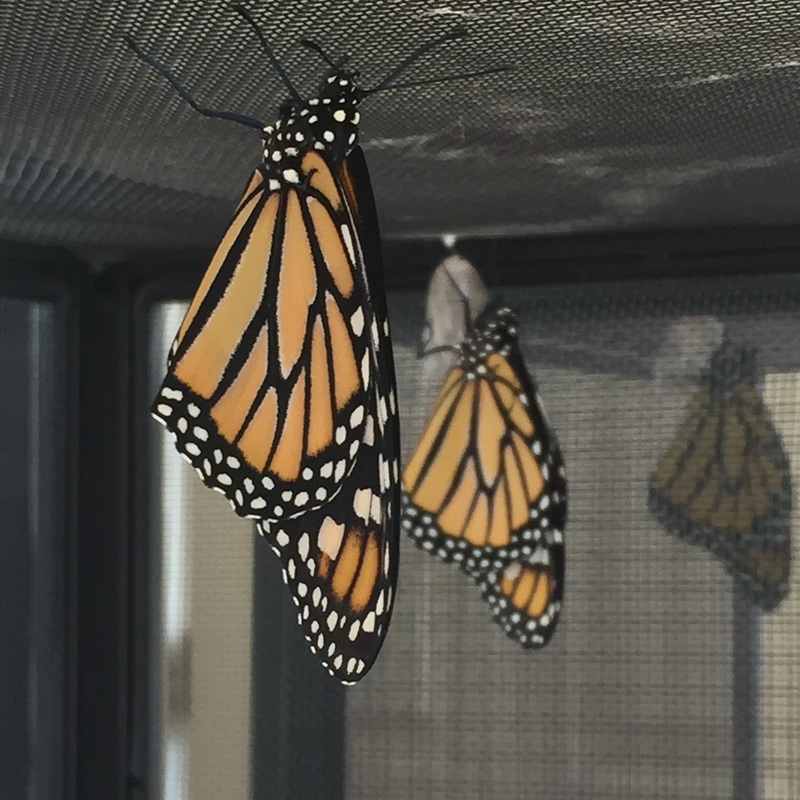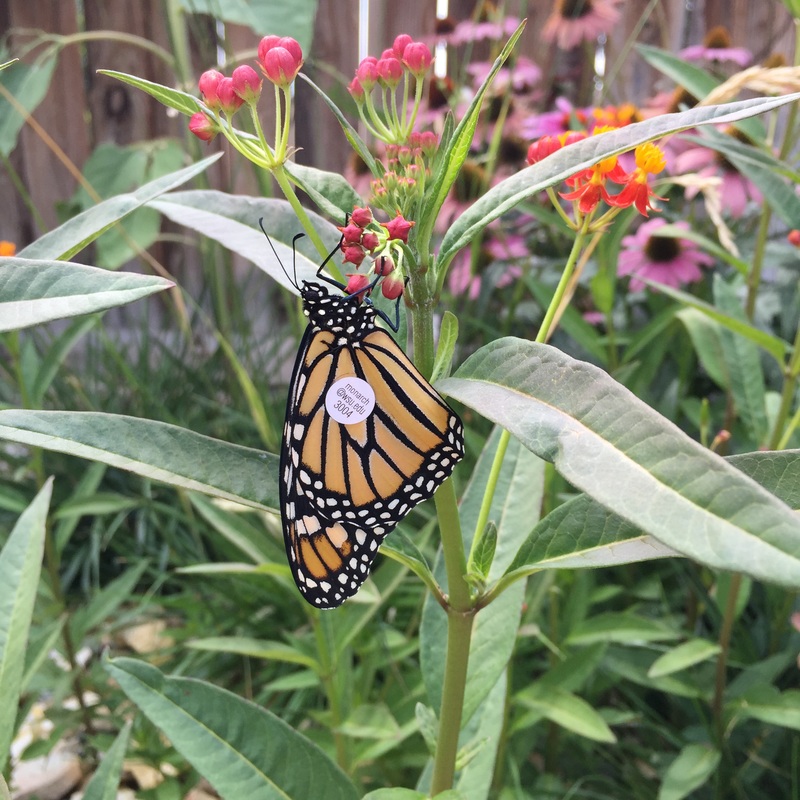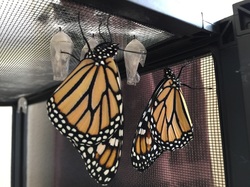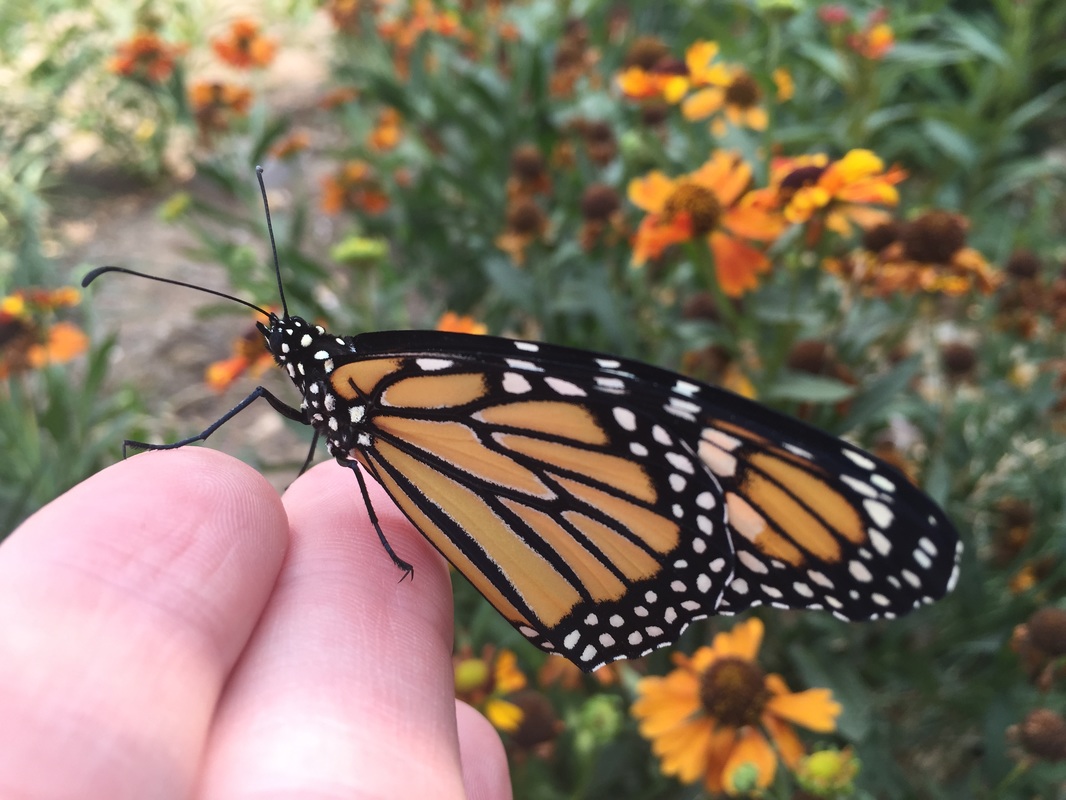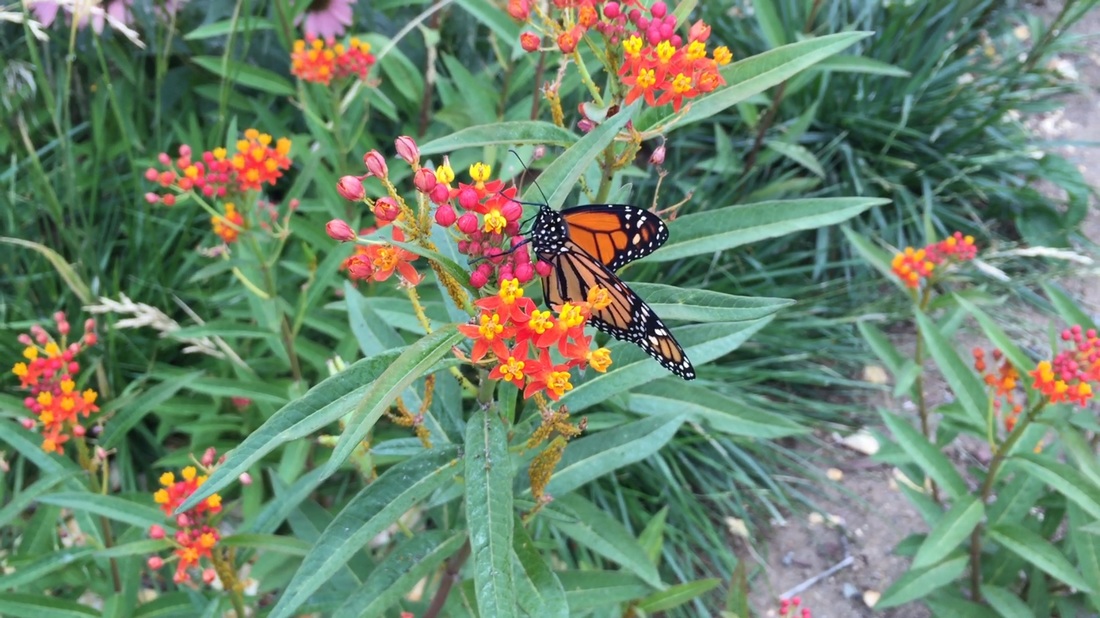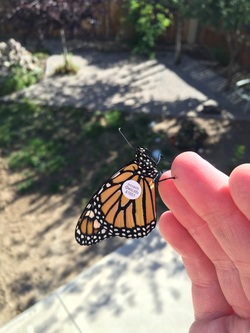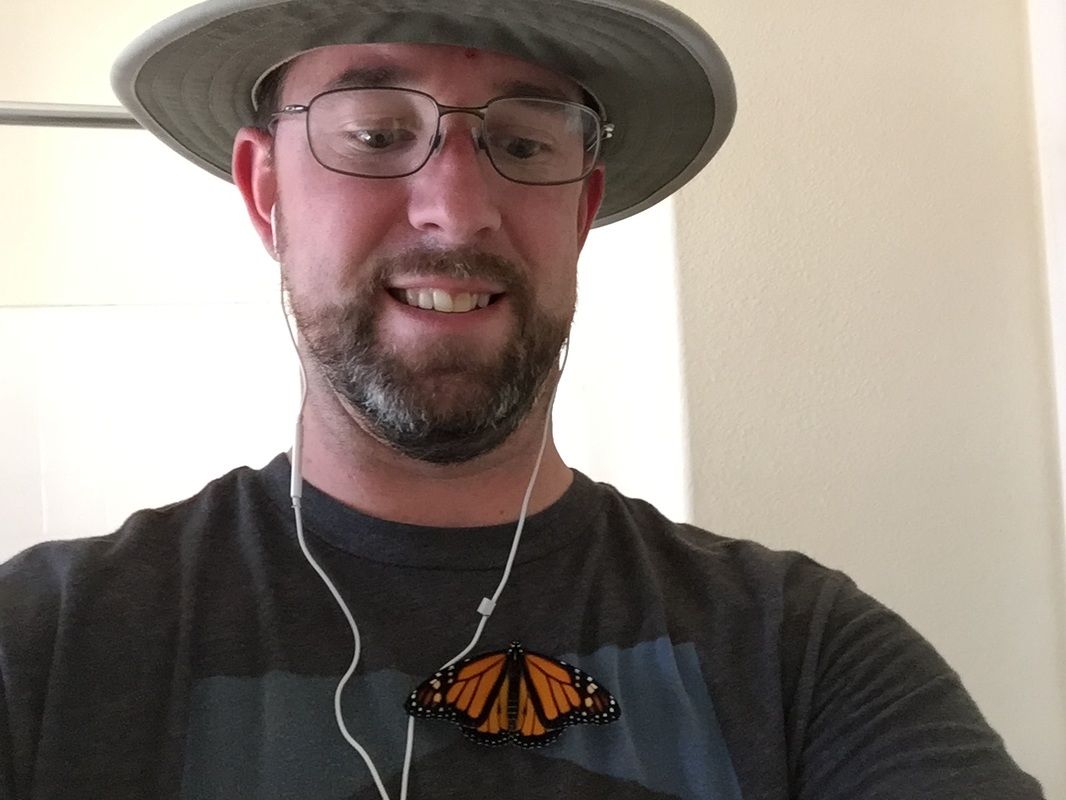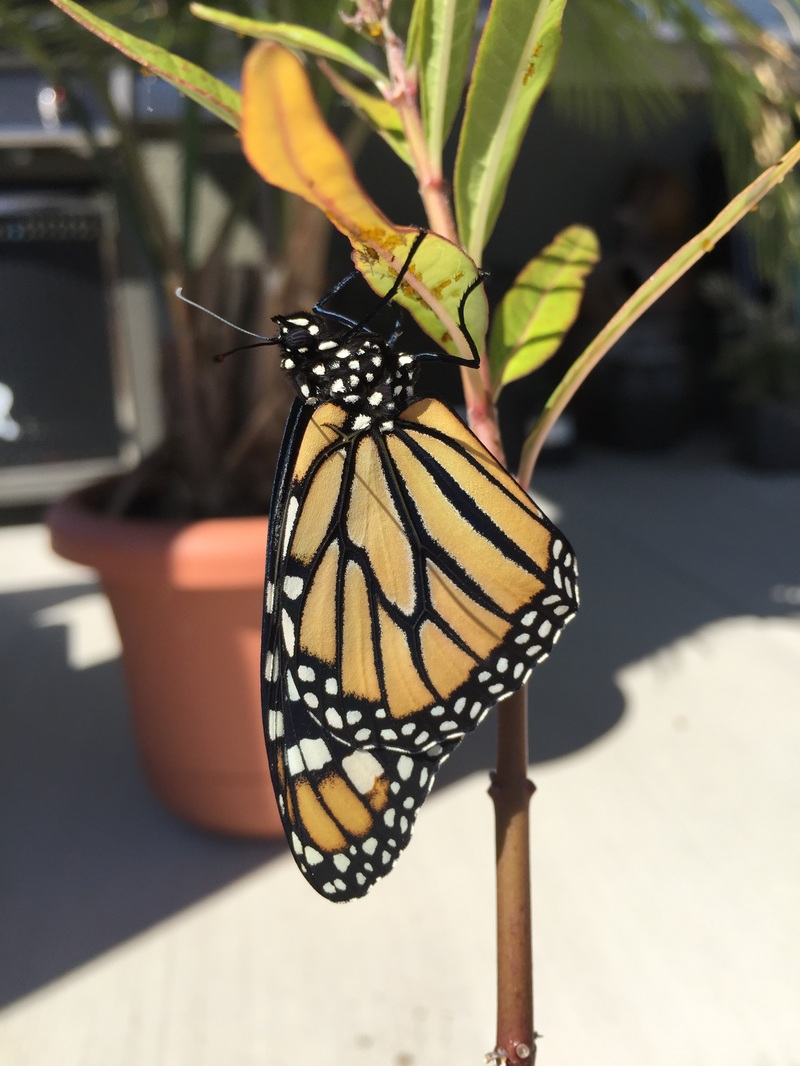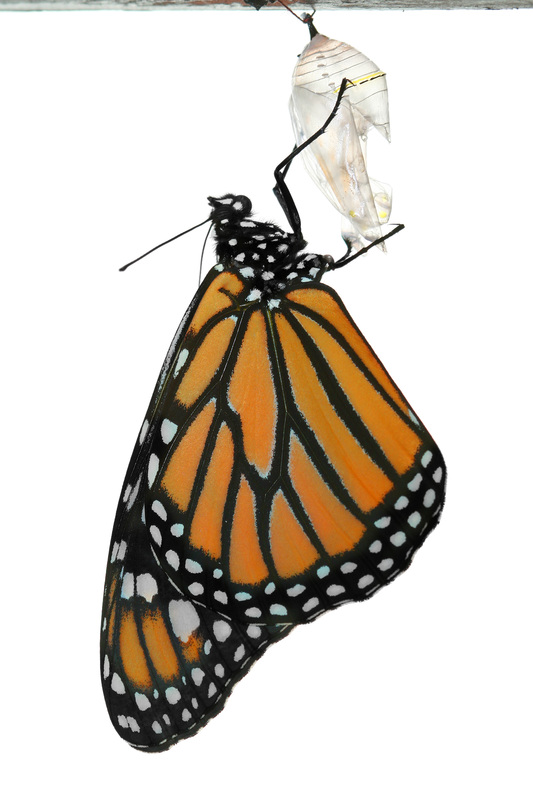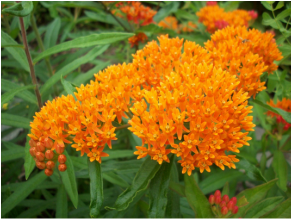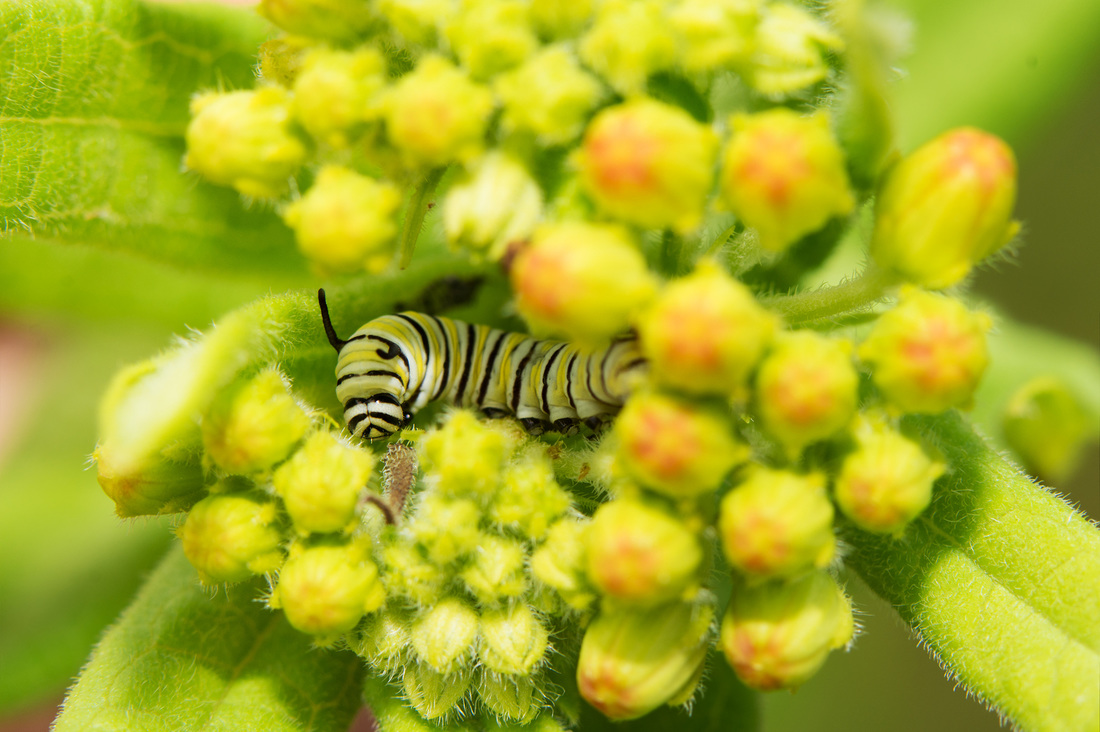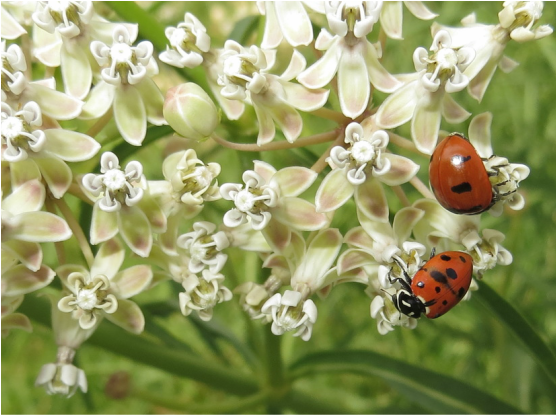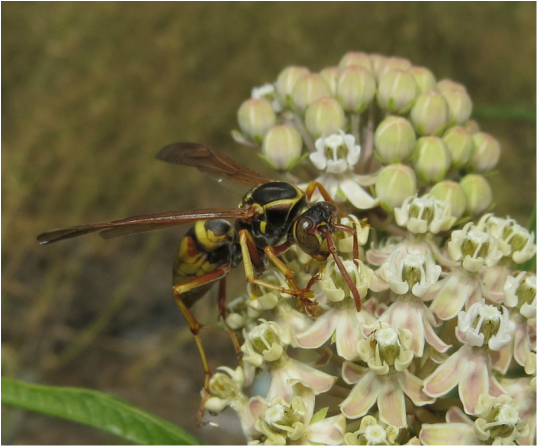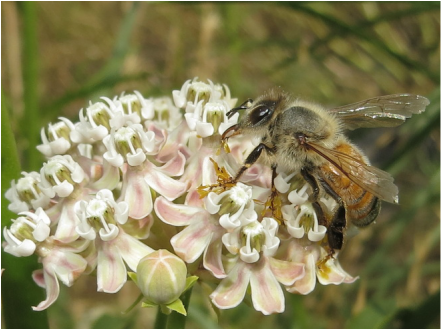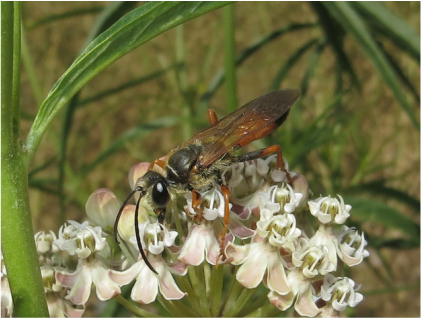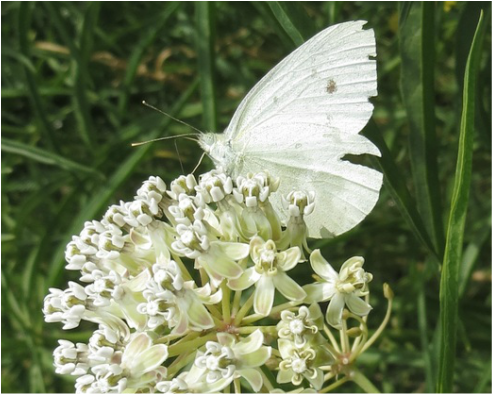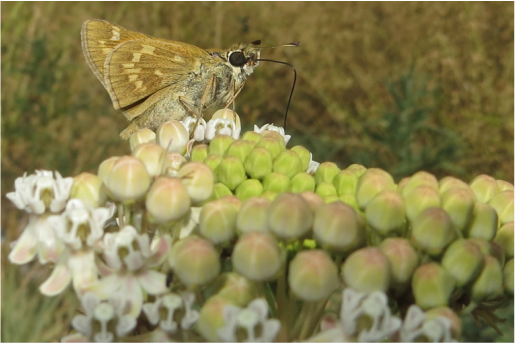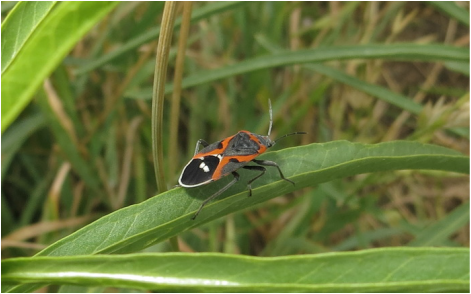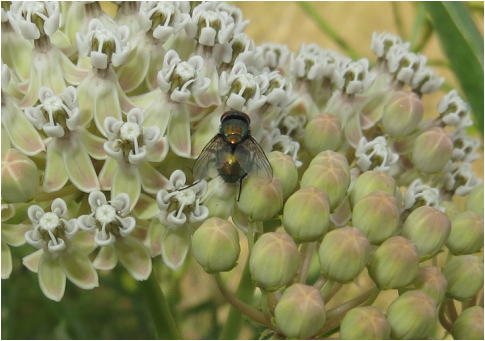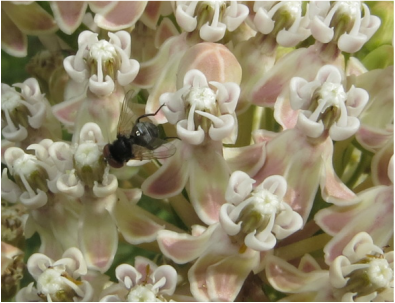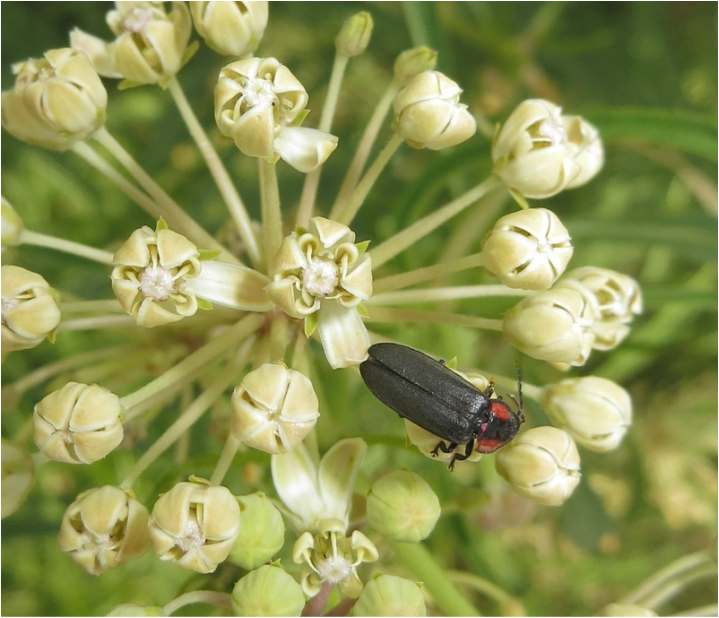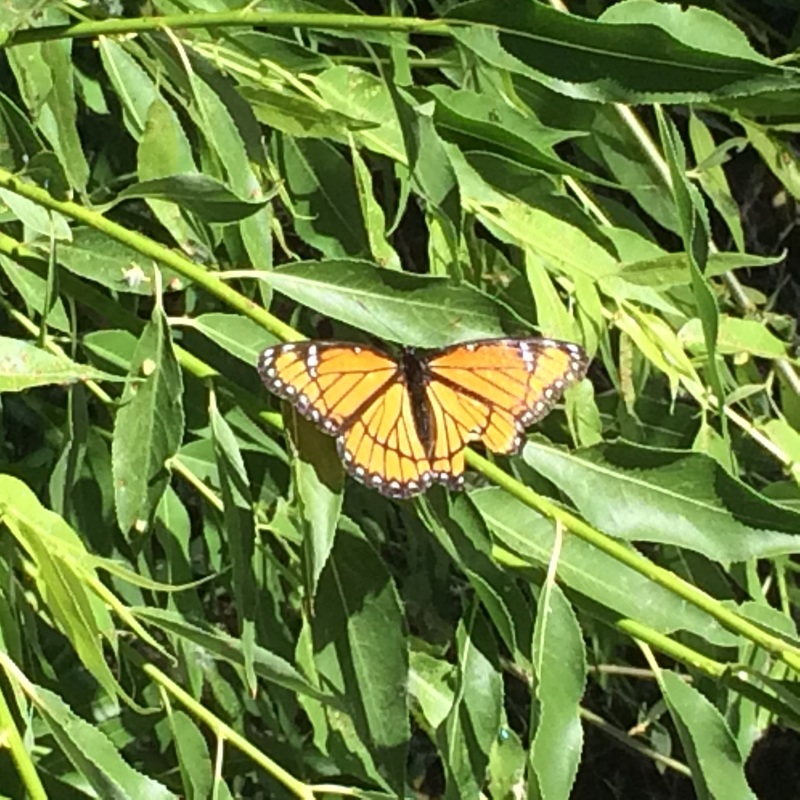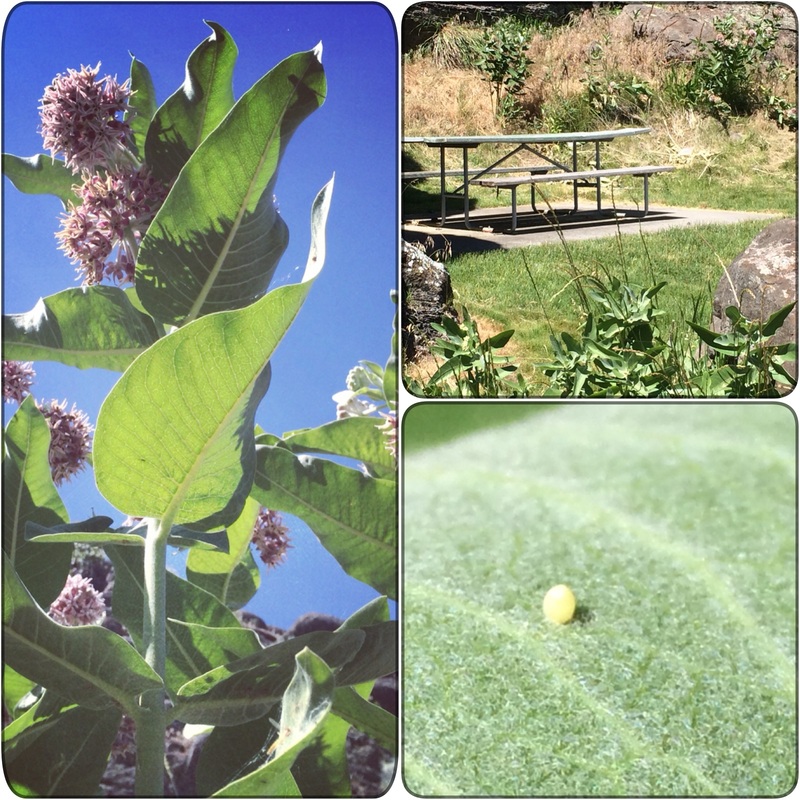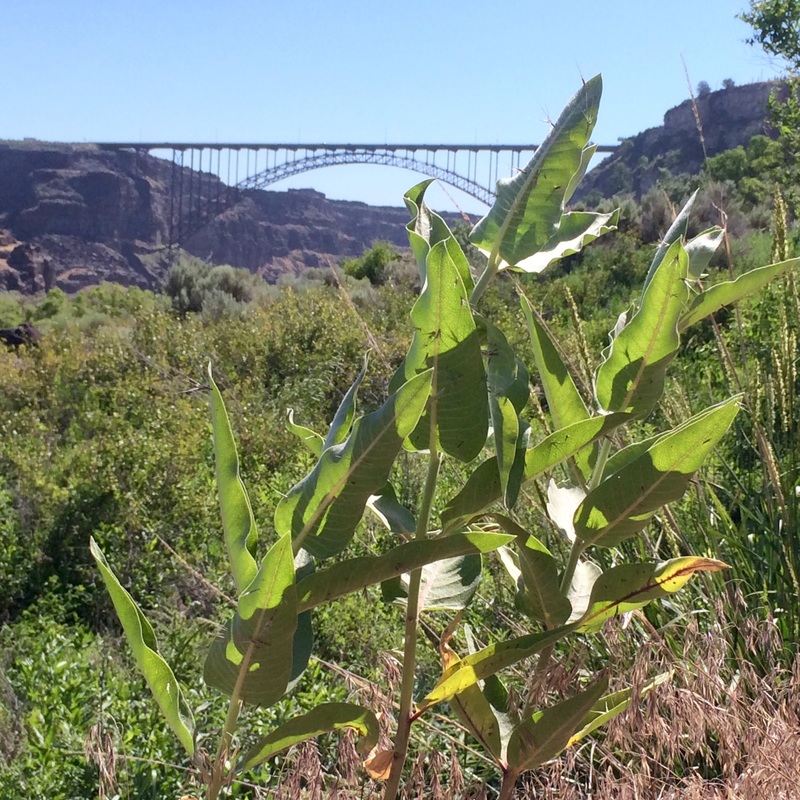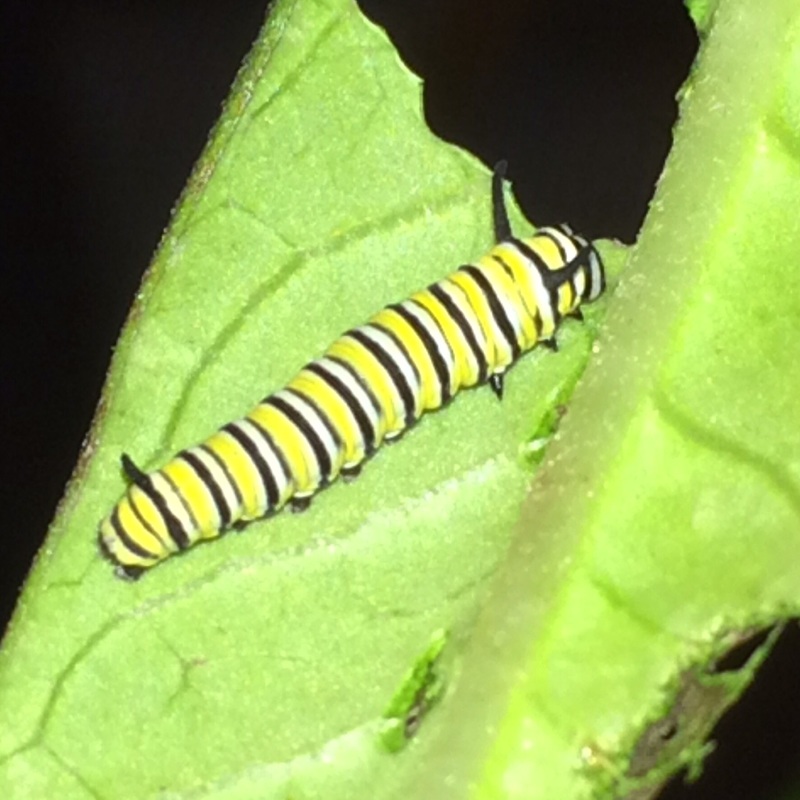Butterfly Circus!
Training a monarch butterfly to dance on your finger isn't easy. It may be impossible. For a few hours after a monarch butterfly emerges from its chrysalis it is dependent on having a safe place to dry it's wings before flying. For that short period of time the monarch is a great companion. For the rest of its life it is your best memory.
Here is the data record of monarch butterflies that were reared at The Biggest Little Butterfly Garden In The World. Monarch Waystation #8269 is a 200 square foot monarch waystation located in my backyard in the town of Sparks, Nevada USA.
8/3/16 #31 Female 8/4/16 #32 Male 8/5/16 #33 Female 8/11/16 #34 Female 8/12/16 #35 Male 8/14/16 #36 Male m 8/14/16 #37 Female 8/21/16 #38 Female 8/22/16 #39 Female WSU tag A1656 8/22/16 #40 Female WSU tag A1657 8/23/16 #41 Male A1658 8/23/16 #42 Male A1659 8/23/16 #43 Male A1660 8/23/16 #44 Female A1661 8/23/16 #45 Male A1662 8/23/16 #46 Female A1663 8/23/16 #47 Female A1664 8/23/16 #48 Male A1665 8/23/16 #49 Female A1666 8/23/16 #50 Female A1667 8/23/16 #51 Female A1668 8/23/16 #52 Female A1669 8/23/16 #53 Male A1670 8/23/16 #54 Male A1671 8/23/16 #55 Female A1672 8/23/16 #56 Male A1673 8/24/16 #57 Female 8/24/16 #58 Female 9/11/16 #59 Male A1674 9/11/16 #60 Male A1675 9/11/16 #61 Female On June 22nd, 2015 I posted a page titled MONARCH BUTTERFLIES ARE EVERYWHERE. At the end of the page I set a goal to raise and release 25 monarch butterflies. "I set a personal goal to raise 2,500% more monarchs in 2015 than I did in 2014." Did I meet my goal? The 2015 Monarch Butterfly Rearing Roundup lets you know how I did at achieving my goal. I couldn't be more satisfied with the results. Take a look at the following multimedia about the monarchs I raised in the summer of 2015. 2015 Monarch #2 Beckham male WSU tag #3015 Monarch #3 Cali female WSU tag #3013 Monarch #4 Diego male WSU tag #3001 Monarch #5 Eva female WSU tag #3002 Monarch #6 Fernando male WSU tag #3003 Monarch #7 Gail female WSU tag #3004 Monarch #8 Hurley male WSU tag #3008 Monarch #9 Iola female WSU tag #3007 Monarch #10 Jesse male WSU tag #3005 Monarch #11 Katniss female WSU tag #3009 Monarch #12 Leaf female WSU tag #3010 Monarch #13 Macon male WSU tag #3011 Monarch #14 Nancy female WSU tag #3012 Monarch #15 Oakley male WSU tag #3014 Monarch #16 Padraic male WSU tag #3016 Monarch #17 Quest male WSU tag #3017 Monarch #18 Rufus male WSU tag #3018 Monarch #19 Scooby male WSU tag #3019 Monarch #20 Talbot male WSU tag #3020 Monarch #21 Uma female WSU tag #3022 Monarch #22 Viper male WSU tag #3023 Monarch #23 Wadsworth male WSU tag #3024 Monarch #24 Xavier male WSU tag #3025 Monarch #25 Yale male WSU tag #A1651 Monarch #26 Zander male WSU tag #A1652 Monarch #27 Agatha female WSU tag #A1653 Monarch #28 Brad male NO TAG undersized Monarch #29 Connor male WSU tag #A1654 Monarch #30 Dean male WSU tag #A1655 WSU Tag wild female #3021 WSU Tag wild male #3006 Beckham
Cali
Diego
EvaEva is a special little monarch. She attached to the vertical wall of the enclosure. A slight tilt to the enclosure helped reduce the pressure on the side of her chrysalis. Eva eclosed at 8:00 8/19/15 Meconium ejected at 8:40. Wings look good!
Fernando
Gail
Hurley
Jesse
Katniss
Leaf
YaleZanderAgatha
Brad9/26/15
Connor
Dean
WSU Tag wild female #3021
Season conclusionI successfully raised and released twenty-nine monarchs in 2015. I had two fatalities in my care. One first instar caterpillar may have been eaten by a larger caterpillar. Another caterpillar fell ill, leaked green liquid and quickly dissolved into a black liquid. Presumably it was a bacterial infection. That was a tough loss. The difficulities were few and the successes far outweighed them. Increasing the amount of milkweed available for monarchs in my yard has created a safe place for them to reproduce. Having a monarch waystation brought the monarchs to the yard throughout the summer months. Last year I was living in a rental home and the yard was not my own. At the end of the season I relocated my potted milkweed to others in the community. The yard is likely to be overhauled with new plants. New for 2016 is my new house, Milkweed Manor. The landscaping in the backyard was a blank slate. A 180 square foot pollinator garden was incorporated into the landscaping. The goal in 2016 is to foster an awareness of milkweed as a favored plant in residential landscaping. By growing native milkweed plants in my own yard I can share the value that the garden has to butterflies, birds and bees. If you are interested in locating native milkweed then please use the Milkweed Locator tool.
Post by: Jonathan Léger
Prepare Your Milkweed for the Monarchs Arrival
The word is out that the population of Monarch butterflies is decreasing. These insects have delighted legions of children on the North American continent for generations and the thought of their demise is distressing to many. Since the caterpillars require milkweed to thrive, residents of cities, suburbs, and rural areas are concentrating their efforts on propagating the species to ensure the survival of this wondrous species. If you have never grown milkweed before, here are some tips that will help your plants grow to be strong and healthy to nurture the Monarch caterpillars long enough for them to reach their butterfly adulthood.
Prepare a garden space that will accommodate at least six plants. When Monarch caterpillars start eating, they are very, very hungry. By giving them access to multiple plants, you create a better opportunity for more of them to survive to adulthood and, after all, isn't that the whole point of growing milkweed in the first place?
Diversify Your Milkweed Garden
To really increase your odds of successfully creating a habitat for these lovely butterflies, begin preparing more than one garden plot for them in the spring. Keep in mind that not every plant thrives, so if you grow your milkweed in multiple locations around your yard, you will increase your odds of success. Even if a storm blows through your area, it might destroy one of your milkweed patches, but it won't destroy your chances.
If you do choose to grow your milkweed in a container garden, you can overwinter them and place them back outside in the springtime for bigger plants that season. Overwintering works for most milkweed varieties, but not all. Move them indoors once they have stopped producing flowers or fruits. Once indoors, remember that they will still need to be watered all winter long. Perennial milkweed will go dormant in the winter and can remain potted outdoors throughout the winter.
Plan Ahead for Next Seasons Monarchs
After you have placed your plants into the soil, remember to put mulch around them. The protective layer of mulch will help to keep moisture in and help your plants to thrive. Leave some open space around the seedlings and check on them after a rain storm to make sure they don't get covered. You can buy a commercial mulch specially made for this purpose or you can use grass clippings. Both work very well.
Once you begin growing your milkweed plants, you can either wait for wild milkweed butterflies to show up to lay their eggs or collect caterpillars from nearby milkweed and place them on your plants. Watching these caterpillars grow to adulthood makes it worth all the work in the spring.
Jonathan Leger is a member of the Garden Writer's Association and a gardening enthusiast.
He runs a site dedicated to the history, education and care of knockout roses at
On July 12th, 2015 I visited an area where mexican whorled milkweed plants are growing. The plants have attracted monarch's and swallowtail butterflies over the last week. Today I took my camera with the goal of photographing a few of the bugs. I was only at the truck stop where the flowers are blooming for no more then 10 minutes and I saw 10 different kinds of bugs. If you can help me identify any of the insects leave a comment below.
Lady bugs, July 2:11 PM
Not just one lady bug but two lady bugs!
Wasp, JULY 2:12 PM
The yellow jacket sometimes appears to be a threatening menace at your backyard BBQ. Here in the milkweed meadow the yellow jacket is a gentle bug searching for pollen.
Bee, JULY 2:13 PM
This bee appears to be a honey bee. It is loading up on pollen. If you look very closely on the bees legs you may be able to see the pollinia packets attached. The bee is fertilizing the blossom and these flowers will most certainly become fruit in the form of seed pods in the next few weeks.
Wasp, JULY 2:14 PM
I could use a bit of help with this wasp identification. Perhaps a Mud Dauber?
Butterfly, JULY 2:15 PM
Cabbage white butterfly seen here is finding an outstanding source of nectar on the mexican whorled milkweed flowers.
Skipper, JULY 2:16 PM
This skipper butterfly is feeding on the milkweed while waiting for the additional blooms to open.
Milkweed Beetle, JULY 2:17 PM
Large milkweed bug. These bugs are pretty common on milkweed. Its a good idea to try and keep the large milkweed bug away from your milkweed when the seed pods form. The large milkweed bug will feed on the seeds. When they do feed on the milkweed seeds the seeds will not grow due to the damage this bug has caused to the seed.
Fly, JULY 2:18 PM
Big fly may be taking a break from flying in the hot sun.
Fly, July 2:19 PM
Small fly. This fly seemed pretty engaged in searching for something on the milkweed flowers.
Beetle, JULY 2:20 PM
I don't have the identification for this beetle. It may be visiting the milkweed while on its way thru the area.
That's 10 bugs in 10 minutes on milkweed
It's not hard to see all the value that milkweed has for pollinators and other insects. My favorite two kinds of bugs today are the butterflies and the bees. I try to pet a bee every day in the summer. Today was no exception. The bees were very friendly, even the yellow jacket.
If I had more time to stay at the milkweed it is very likely that I would have seen a monarch butterfly visit the plants. On a few visits here earlier in the summer I had seen a few different monarchs flying over and landing on these flowers. If you are interested in growing mexican whorled milkweed in your yard or garden then you can pre-order the seeds now and expect delivery before the end of November. Visit the store to order milkweed seeds. Monarch's are now all over North America. Mexico has monarchs. America has monarchs. Canada has monarchs. Summertime is primetime for monarchs to migrate. Use the milkweed locater to see which type of milkweed is native to your state. Monarchs are not on My Milkweed, Why?The distribution of monarchs can appear to be uneven at times. I am happy to have seen a total of three monarchs in my yard this year. It is still early in the monarch's migration season. No eggs have been laid on my milkweed yet. The milkweed patch is a busy habitat for hundreds of animals that visit the plant throughout the summer. Bees are actively pollinating the blooms. Spiders are laying in wait for tiny bugs. Tiny bugs are striving to survive on the milkweed plants. One of the smallest animals on milkweed is the monarch caterpillar. Caterpillars can be very difficult to see when they are small. A newly hatched caterpillar is only 2-6mm in length (source: Monarch Watch) and nearly transparent. The day after my latest caterpillar hatched I didn't see it on the milkweed until two days later. They could be hiding out in the open. Monarchs need time to reproduceThe monarch lifecycle is an amazing process. Metamorphosis is incredibly complex and requires that many steps in the process goes well for the monarch to take flight. An entire metamorphosis from egg to butterfly occurs in about 30 days. As monarchs enter your region of N. America they may be at the end of their short life. An egg laying female is likely to lay as many as 500 eggs on the milkweed plants in her lifetime. Those eggs take about a week to hatch the tiny caterpillar. It may be another week before you notice the leaves being chewed up by the hungry caterpillars. Once the caterpillars have grown thru five instars they may have crawled away from the milkweed to form the chrysalis. The chrysalis is the last step in metamorphosis before the butterfly takes flight. As fun as looking for monarchs in flight can be, we may be looking in the wrong place. Egg, caterpillar and chrysalis are also monarchs that haven't gotten ready to fly. Take some time to look at the milkweed throughly. Eggs are small, oblong and have a light gold color. You may find an egg before you see a monarch. Monarch eggs in Twin Falls, IdahoWhile traveling to attend a wedding visited a park that I went to in 2014. There was milkweed in the park in 2014 so I was hopeful to find monarchs in 2015. While I did not see any monarchs, I did see a viceroy butterfly.
Raising monarchs at homeIn one month a monarch can be raised in your home. With a little preparation and a lot of patience you can contribute to the monarch butterfly population explosion that is overdue. I have a goal to raise and release twenty-five healthy monarch butterflies in 2015. The most natural approach to supporting monarchs is to grow milkweed on your property. Monarch waystations and pollinator gardens are hugely successful and provide wonderful habitats for monarchs and other beneficial insects. Currently I am growing milkweed in a monarch waystation. The name of my way station is "The Biggest Little Butterfly Garden In The World" Monarch waystation #8269 as registered with the Monarch Watch Waystation Program. Registering your garden is not necessary. I chose to register and even ordered the cool sign. I consider it a donation to a good cause. The monarchs habitat is a cruel unforgiving place to grow up. Spending a month outside in the elements is dangerous, even in the summer, for a monarch larvae. Eggs get eaten, caterpillars become meals. Chrysalids can become damaged. Any one of these events will kill that monarch larvae. To control the process I am trying to raise this years 25 monarchs indoors. By preventing eggs from being eaten. Keeping caterpillars from becoming meals. And by hosting the chrysalids in a safe place I plan to increase the survival rate from a dismal 5% to above 75%. Some folks raising monarchs report successful rearing of above 95%. By removing a few variable from the environment the monarchs stand a better chance of completing their metamorphosis. From One to Twenty-Five in only One Year
|
Site SearchAuthorMake milkweed your friend. Your friends will love your milkweed. My name is Brad. Learn more about me now. Blog Archives
March 2022
Blog Categories
All
email Subscriber archive |
-
Home
- About
- Why Grow Milkweed Plants
- Contact
-
Map
>
-
USA
>
- Alabama
- Alaska
- Arizona
- Arkansas
- California
- Colorado
- Connecticut
- Delaware
- District of Columbia
- Florida
- Georgia
- Hawaii
- Idaho
- Illinois
- Indiana
- Iowa
- Kansas
- Kentucky
- Louisiana
- Maine
- Maryland
- Massachusetts
- Michigan
- Minnesota
- Mississippi
- Missouri
- Montana
- Nebraska
- Nevada
- New Hampshire
- New Jersey
- New Mexico
- New York
- North Carolina
- North Dakota
- Ohio
- Oklahoma
- Oregon
- Pennsylvania
- Rhode Island
- South Carolina
- South Dakota
- Tennessee
- Texas
- Utah
- Vermont
- Virginia
- Washington
- West Virginia
- Wisconsin
- Wyoming
- Canada >
- Mexico >
-
USA
>
- FAQ
-
Milkweed
- Aquatic milkweed, Asclepias perennis
- Arizona milkweed, Asclepias angustifolia
- Bear mountain milkweed, Asclepias scaposa
- Bract milkweed, Asclepias brachystephana
- Broadleaf milkweed, Asclepias latifolia
- Butterfly milkweed, Asclepias tuberosa
- California milkweed, Asclepias californica
- Carolina milkweed, Asclepias cinerea
- Clasping milkweed, Asclepias amplexicaulis
- Common milkweed, Asclepias syriaca
- Curtiss' milkweed, Asclepias curtissii
- Cutler's milkweed, Asclepias cutleri
- Desert milkweed, Asclepias erosa
- Dwarf milkweed, Asclepias involucrata
- Emory's milkweed, Asclepias emoryi
- Engelmann's milkweed, Asclepias engelmanniana
- Fewflower milkweed, Asclepias lanceolata
- Florida milkweed, Asclepias feayi
- Fourleaf milkweed, Asclepias quadrifolia
- Green antelopehorn, Asclepias viridis
- Green Comet milkweed, Asclepias viridiflora
- Greene's milkweed, Asclepias californica ssp. greenei
- Hall's milkweed, Asclepias hallii
- Heartleaf milkweed, Asclepias cordifolia
- Horsetail milkweed, Asclepias subverticillata
- Jewel milkweed, Asclepias cryptoceras
- Largeflower milkweed, Asclepias connivens
- Lemmon's milkweed, Asclepias lemmonii
- Longhood milkweed, Asclepias macrotis
- Longleaf milkweed, Asclepias longifolia
- Mahogany milkweed, Asclepias hypoleuca
- Mead's milkweed, Asclepias meadii
- Mexican whorled milkweed, Asclepias fascicularis
- Michaux's milkweed, Asclepias michauxii
- Mojave milkweed, Asclepias nyctaginifolia
- Nodding milkweed, Asclepias glaucescens
- Oval-leaf milkweed, Asclepias ovalifolia
- Parish's woolly milkweed, Asclepias vestita
- Pineland milkweed, Asclepias obovata
- Pineneedle milkweed, Asclepias linaria
- Pinewoods milkweed, Asclepias humistrata
- Plains milkweed, Asclepias pumila
- Poke milkweed, Asclepias exaltata
- Prairie milkweed, Asclepias sullivantii
- Prostrate milkweed, Asclepias prostrata
- Purple milkweed, Asclepias purpurascens
- Red milkweed, Asclepias rubra
- Redring milkweed, Asclepias variegata
- Rusby's milkweed, Asclepias rusbyi
- Rush milkweed, Asclepias subulata
- Ruth's milkweed, Asclepias uncialis
- Sand milkweed, Asclepias arenaria
- Savannah milkweed, Asclepias pedicellata
- Serpentine milkweed, Asclepias solanoana
- Showy milkweed, Asclepias speciosa
- Sidecluster milkweed, Asclepias lanuginosa
- Slim milkweed, Asclepias linearis
- Slimleaf milkweed, Asclepias stenophylla
- Slimpod milkweed, Asclepias quinquedentata
- Southern milkweed, Asclepias viridula
- Sperry's milkweed, Asclepias sperryi
- Spider milkweed, Asclepias asperula
- Swamp milkweed, Asclepias incarnata
- Swamp milkweed, Asclepias incarnata ssp. pulchra
- Tall green milkweed, Asclepias hirtella
- Texas milkweed, Asclepias texana
- Tuba milkweed, Asclepias tomentosa
- Tufted milkweed, Asclepias nummularia
- Utah milkweed, Asclepias labriformis
- Welsh's milkweed, Asclepias welshii
- Wheel milkweed, Asclepias uncialis
- Whitestem milkweed, Asclepias albicans
- Whorled milkweed, Asclepias verticillata
- Woolly milkweed, Asclepias vestita
- Woollypod milkweed, Asclepias eriocarpa
- Zizotes milkweed, Asclepias oenotheroides
- Store
- Podcast
- Blog
- Resources
-
Home
- About
- Why Grow Milkweed Plants
- Contact
-
Map
>
-
USA
>
- Alabama
- Alaska
- Arizona
- Arkansas
- California
- Colorado
- Connecticut
- Delaware
- District of Columbia
- Florida
- Georgia
- Hawaii
- Idaho
- Illinois
- Indiana
- Iowa
- Kansas
- Kentucky
- Louisiana
- Maine
- Maryland
- Massachusetts
- Michigan
- Minnesota
- Mississippi
- Missouri
- Montana
- Nebraska
- Nevada
- New Hampshire
- New Jersey
- New Mexico
- New York
- North Carolina
- North Dakota
- Ohio
- Oklahoma
- Oregon
- Pennsylvania
- Rhode Island
- South Carolina
- South Dakota
- Tennessee
- Texas
- Utah
- Vermont
- Virginia
- Washington
- West Virginia
- Wisconsin
- Wyoming
- Canada >
- Mexico >
-
USA
>
- FAQ
-
Milkweed
- Aquatic milkweed, Asclepias perennis
- Arizona milkweed, Asclepias angustifolia
- Bear mountain milkweed, Asclepias scaposa
- Bract milkweed, Asclepias brachystephana
- Broadleaf milkweed, Asclepias latifolia
- Butterfly milkweed, Asclepias tuberosa
- California milkweed, Asclepias californica
- Carolina milkweed, Asclepias cinerea
- Clasping milkweed, Asclepias amplexicaulis
- Common milkweed, Asclepias syriaca
- Curtiss' milkweed, Asclepias curtissii
- Cutler's milkweed, Asclepias cutleri
- Desert milkweed, Asclepias erosa
- Dwarf milkweed, Asclepias involucrata
- Emory's milkweed, Asclepias emoryi
- Engelmann's milkweed, Asclepias engelmanniana
- Fewflower milkweed, Asclepias lanceolata
- Florida milkweed, Asclepias feayi
- Fourleaf milkweed, Asclepias quadrifolia
- Green antelopehorn, Asclepias viridis
- Green Comet milkweed, Asclepias viridiflora
- Greene's milkweed, Asclepias californica ssp. greenei
- Hall's milkweed, Asclepias hallii
- Heartleaf milkweed, Asclepias cordifolia
- Horsetail milkweed, Asclepias subverticillata
- Jewel milkweed, Asclepias cryptoceras
- Largeflower milkweed, Asclepias connivens
- Lemmon's milkweed, Asclepias lemmonii
- Longhood milkweed, Asclepias macrotis
- Longleaf milkweed, Asclepias longifolia
- Mahogany milkweed, Asclepias hypoleuca
- Mead's milkweed, Asclepias meadii
- Mexican whorled milkweed, Asclepias fascicularis
- Michaux's milkweed, Asclepias michauxii
- Mojave milkweed, Asclepias nyctaginifolia
- Nodding milkweed, Asclepias glaucescens
- Oval-leaf milkweed, Asclepias ovalifolia
- Parish's woolly milkweed, Asclepias vestita
- Pineland milkweed, Asclepias obovata
- Pineneedle milkweed, Asclepias linaria
- Pinewoods milkweed, Asclepias humistrata
- Plains milkweed, Asclepias pumila
- Poke milkweed, Asclepias exaltata
- Prairie milkweed, Asclepias sullivantii
- Prostrate milkweed, Asclepias prostrata
- Purple milkweed, Asclepias purpurascens
- Red milkweed, Asclepias rubra
- Redring milkweed, Asclepias variegata
- Rusby's milkweed, Asclepias rusbyi
- Rush milkweed, Asclepias subulata
- Ruth's milkweed, Asclepias uncialis
- Sand milkweed, Asclepias arenaria
- Savannah milkweed, Asclepias pedicellata
- Serpentine milkweed, Asclepias solanoana
- Showy milkweed, Asclepias speciosa
- Sidecluster milkweed, Asclepias lanuginosa
- Slim milkweed, Asclepias linearis
- Slimleaf milkweed, Asclepias stenophylla
- Slimpod milkweed, Asclepias quinquedentata
- Southern milkweed, Asclepias viridula
- Sperry's milkweed, Asclepias sperryi
- Spider milkweed, Asclepias asperula
- Swamp milkweed, Asclepias incarnata
- Swamp milkweed, Asclepias incarnata ssp. pulchra
- Tall green milkweed, Asclepias hirtella
- Texas milkweed, Asclepias texana
- Tuba milkweed, Asclepias tomentosa
- Tufted milkweed, Asclepias nummularia
- Utah milkweed, Asclepias labriformis
- Welsh's milkweed, Asclepias welshii
- Wheel milkweed, Asclepias uncialis
- Whitestem milkweed, Asclepias albicans
- Whorled milkweed, Asclepias verticillata
- Woolly milkweed, Asclepias vestita
- Woollypod milkweed, Asclepias eriocarpa
- Zizotes milkweed, Asclepias oenotheroides
- Store
- Podcast
- Blog
- Resources

